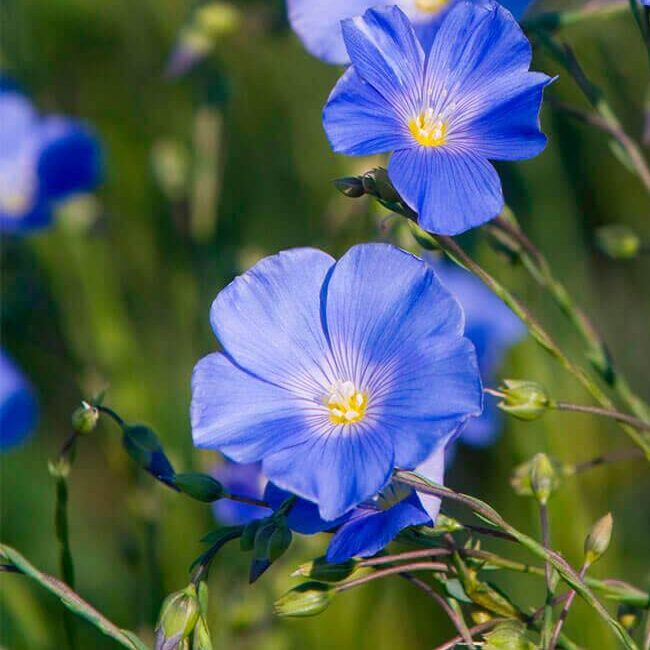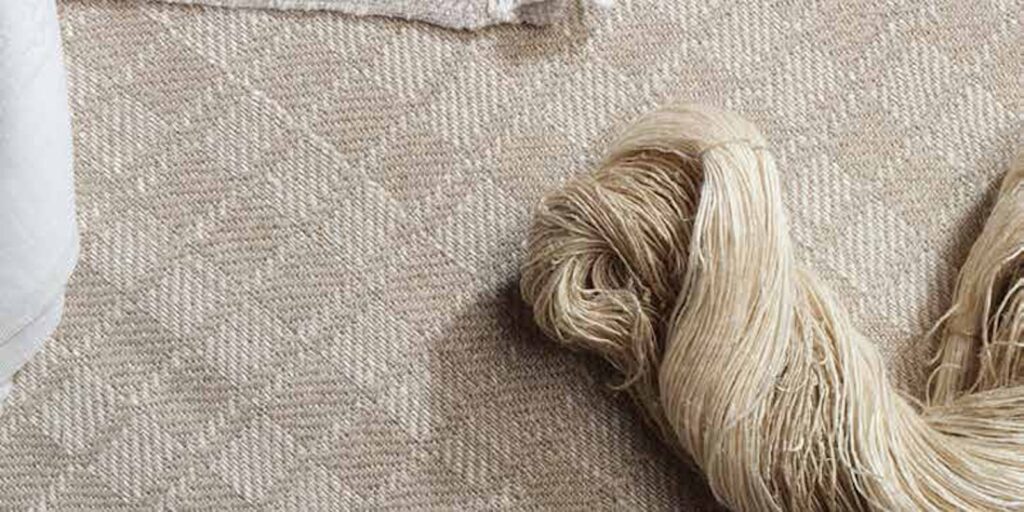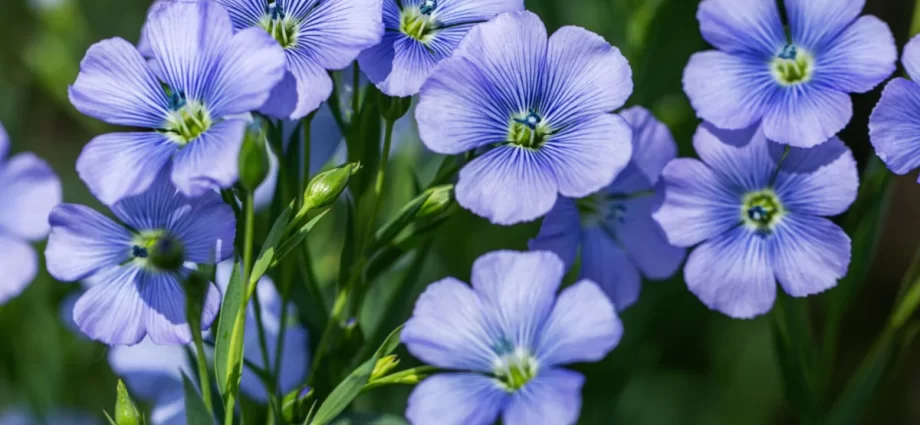What is Flax?
Flax (Linum usitatissimum) is a plant that’s grown in cooler places around the world. People plant its seeds in the early part of the year, and it takes about 100 days to grow. Renowned for its slender stems, it is primarily grown for its valuable fibers and seeds, contributing to the production of linen textiles and nutrient-rich flaxseed oil. Flax plants typically reach a height of around 2 to 4 feet and have blue flowers.

Flax In Textiles?
In textiles, flax refers to a natural fiber derived from the flax plant (Linum usitatissimum), renowned for its significant role in producing linen. Cultivated in various regions, flax fibers are extracted from the plant’s stems, spun into yarn, and woven to create linen fabric.

Characteristics of Flax Fiber
Here’s the main characteristics of flax fiber,
- Strength and Durability: Known for inherent strength and durability.
- Length and Fineness: Long and fine fibers, ideal for quality yarns.
- Smooth Texture: Provides a comfortable and soft feel.
- Color Variations: Natural shades of ivory, tan, and gray.
- Moisture Absorption: Efficient moisture-wicking properties.
- Breathability: Linen fabrics allow air circulation, suitable for warm weather.
- Cooling Properties: Linen offers a cool sensation in hot climates.
- Environmental Friendliness: Requires fewer pesticides and fertilizers.
- Versatility: Used in textiles and industrial applications.
- Biodegradability: Biodegradable, contributing to environmental sustainability.
Use case of Flax Fibers
Flax fiber has become a go-to material for many products. Whether it’s comfy linen clothing or durable home textiles, flax fibers are loved for their strength and eco-friendly nature. People appreciate them for being breathable, long-lasting, and kind to the environment. Here is the products and or use case of flax fiber.
- Linen Fabrics: Linen, a textile made from flax fibers, is widely used for clothing, including shirts, blouses, dresses, skirts, and summer-weight suits. Its natural breathability and cool feel make it popular in warm climates.
- Bed Linens: Linen sheets, pillowcases, and duvet covers are sought after for their comfort and moisture-wicking properties, providing a cool and comfortable sleep environment.
- Tablecloths and Napkins: Linen’s natural elegance and durability make it a popular choice for tablecloths and napkins, adding a touch of sophistication to dining settings.
- Towels: Linen towels are known for their high absorbency and quick-drying properties, making them suitable for bath and kitchen use.
- Home Décor Items: Flax fibers are used to create a range of home decor items such as curtains, drapes, and upholstery fabrics, adding a touch of natural elegance to living spaces.
- Accessories: Flax fibers are utilized in the production of various accessories, including hats, scarves, and handbags, combining style with the breathability and comfort of linen.
- Industrial Textiles: Flax fibers are increasingly being used in industrial applications, including the production of composite materials for automotive interiors and components, taking advantage of their strength and lightweight characteristics.
- Footwear: Linen fabrics may be used in the production of breathable and comfortable footwear, particularly insoles and linings.
- Specialty Textiles: Flax fibers are also employed in specialty textiles for specific purposes, such as fire-resistant and antimicrobial textiles, expanding their applications in various industries.
- Fashion Accessories: Flax fibers can be woven or blended with other materials to create fashion accessories like belts, ties, and hats, offering a natural and stylish option.
Types of Flax Fiber
Flax fibers can be categorized into two main types based on their location within the flax stem and their characteristics:
Long Line Fibers:
- Location: Found in the outer layers of the flax stem, also known as the bast or phloem.
- Characteristics: Long, fine fibers with high strength and durability.
- Uses: Long line fibers are typically used for high-quality textiles, including linen fabrics for clothing, bed linens, and other home textiles. They are also used in the production of specialty industrial materials.
Short Tow Fibers:
- Location: Found in the inner layers of the flax stem, also known as the core or woody part.
- Characteristics: Shorter fibers that are coarser and less uniform than long line fibers.
- Uses: Short tow fibers are often used in the production of coarser textiles, such as lower-grade linens or certain industrial materials. They may be used for products where the aesthetic and tactile qualities of the fiber are less critical.
Production process of flax fiber & products
- Cultivation:
- Flax plants (Linum usitatissimum) are cultivated in fields. The flax plant is an annual herb that is typically grown in cooler climates.
- Flax plants (Linum usitatissimum) are cultivated in fields. The flax plant is an annual herb that is typically grown in cooler climates.
- Harvesting:
- The flax plant is usually harvested when it’s in bloom, typically in the summer. Harvesting involves cutting the plants close to the ground.
- The flax plant is usually harvested when it’s in bloom, typically in the summer. Harvesting involves cutting the plants close to the ground.
- Retting:
- Retting is a crucial step to separate the fibers from the woody stem of the flax plant. There are different methods of retting, but the most common ones are water retting and dew retting.
- Water retting involves soaking the harvested flax stems in water to encourage microbial activity, which breaks down the pectins that bind the fibers to the stem.
- Dew retting utilizes natural moisture from the environment to achieve a similar effect. This process can take a few weeks.
- Drying:
- After retting, the flax fibers are dried to remove excess moisture. This can be done naturally in the sun or through artificial drying methods.
- After retting, the flax fibers are dried to remove excess moisture. This can be done naturally in the sun or through artificial drying methods.
- Breaking and Scutching:
- Once dried, the flax stems undergo a process known as breaking, where the dry stems are mechanically broken to release the fibers.
- Scutching follows breaking and involves further separating the fibers from impurities such as small pieces of stem. This is often done using mechanical tools.
- Hackling:
- The hackling process involves combing the fibers to align them and remove any remaining impurities. This results in long, fine flax fibers ready for spinning.
- The hackling process involves combing the fibers to align them and remove any remaining impurities. This results in long, fine flax fibers ready for spinning.
- Spinning:
- The prepared flax fibers are then spun into yarn or thread. Spinning can be done using traditional spinning wheels or modern machinery.
- The prepared flax fibers are then spun into yarn or thread. Spinning can be done using traditional spinning wheels or modern machinery.
- Weaving or Knitting:
- The spun flax yarn is woven or knitted into fabric, creating the final textile product.
- The spun flax yarn is woven or knitted into fabric, creating the final textile product.
- Dyeing and Finishing:
- If necessary, the fabric may undergo dyeing to achieve the desired color. Afterward, it goes through finishing processes to enhance qualities like softness or texture.
- If necessary, the fabric may undergo dyeing to achieve the desired color. Afterward, it goes through finishing processes to enhance qualities like softness or texture.
- Manufacturing:
- The final flax-based products, such as clothing, bed linens, or industrial materials, are manufactured using the woven or knitted flax fabric.
In conclusion, flax fiber, particularly in the form of linen, stands out as a remarkable and sustainable material with a rich history. From its cultivation to the creation of versatile products like linen clothing and home textiles, flax offers strength, comfort, and an eco-friendly choice.

